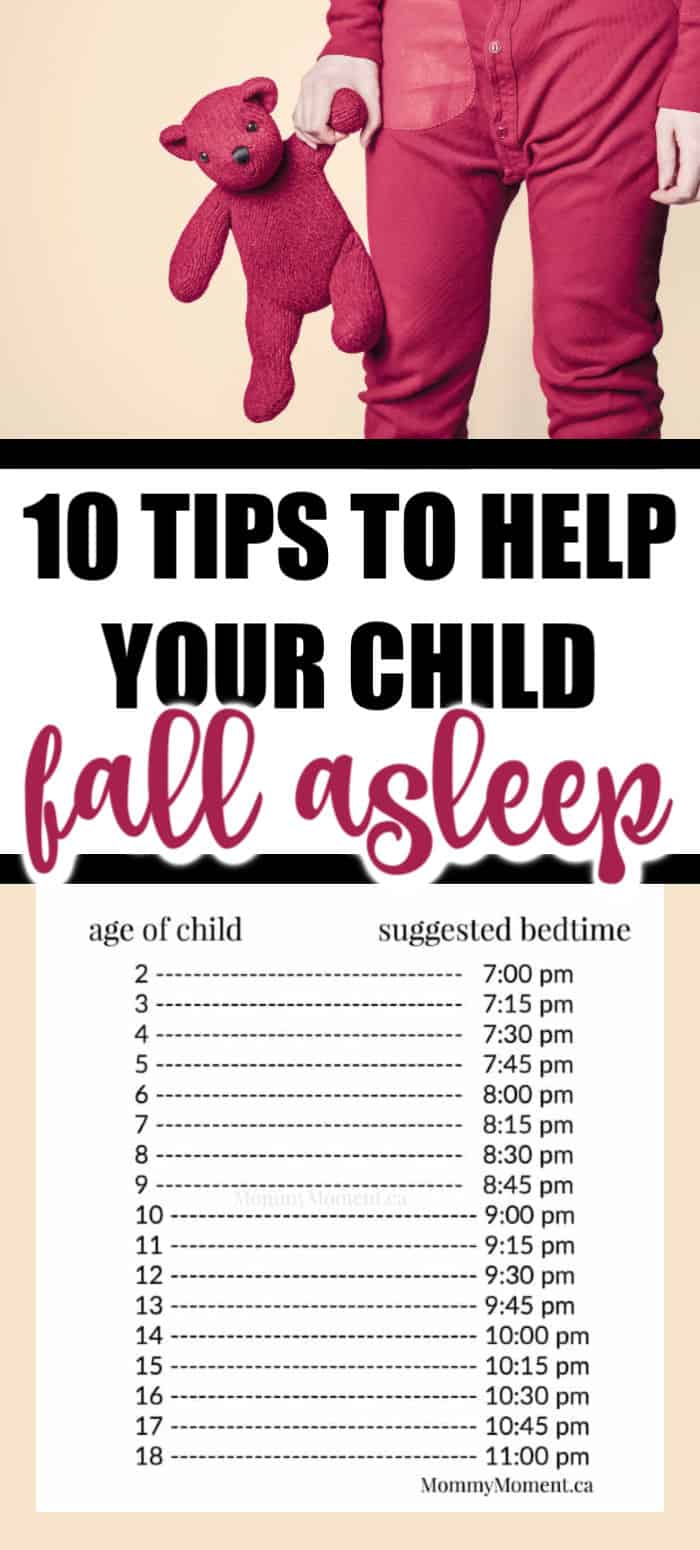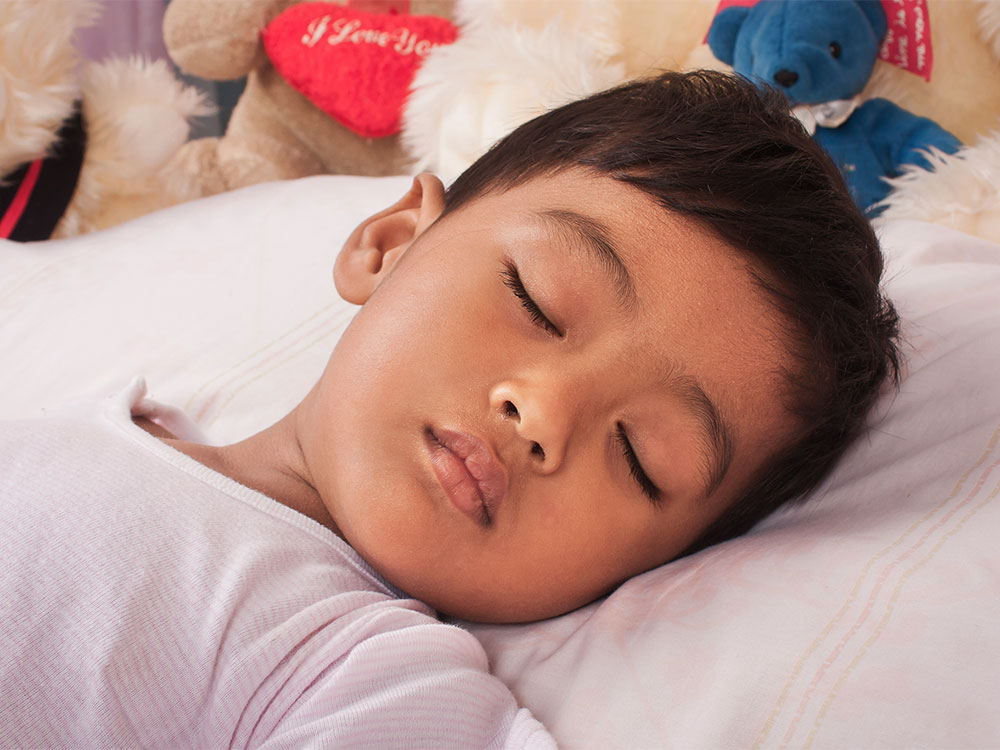Sleep is important for everyone, especially for kids. Good sleep helps with learning, mood, and health.
But sometimes, falling asleep can be hard, especially for a 10-year-old. In this post, we will share simple tips and tricks that can help kids sleep faster. These methods are easy to follow and can make bedtime more relaxing. From creating a cozy bedtime routine to using calming techniques, these ideas are perfect for young ones.
With the right habits, any child can enjoy a good night’s sleep. So, let’s explore these fun and helpful tips to make falling asleep easier and more enjoyable!

Credit: mommymoment.ca
The Importance Of Sleep For Children
Sleep is very important for children. It helps them grow and learn. Without enough sleep, kids can feel tired and cranky. They may also have trouble focusing in school. Let’s look at why sleep matters for children.
Physical Growth And Development
Sleep plays a big role in physical growth. During sleep, the body releases growth hormones. These hormones help kids grow taller and stronger.
Here are some key points about sleep and growth:
- Sleep supports muscle growth.
- It helps repair tissues.
- Sleep boosts the immune system.
Kids need different amounts of sleep as they grow. Here’s a quick guide:
| Age Group | Recommended Sleep (Hours) |
|---|---|
| 5-10 years | 9-11 hours |
| 11-14 years | 8-10 hours |
Cognitive Function And School Performance
Sleep greatly affects how well kids think and learn. It helps with memory and attention. Kids who sleep well usually do better in school.
Here’s how sleep benefits cognitive function:
- Improves focus and attention.
- Enhances problem-solving skills.
- Boosts creativity and imagination.
Good sleep can lead to higher grades. Kids who sleep enough often feel happier. They can handle stress better too.
Recognizing Sleep Challenges In 10-year-olds
Many 10-year-olds face sleep challenges. These issues can affect their mood, focus, and overall health. Recognizing signs of sleep problems is essential. Parents can help their children sleep better. Here, we will explore the signs of sleep deprivation and common sleep disorders.
Signs Of Sleep Deprivation
Sleep deprivation can happen for many reasons. Kids may not get enough sleep due to busy schedules or distractions. Here are some common signs:
- Difficulty waking up: Struggling to get out of bed.
- Daytime sleepiness: Feeling tired or drowsy during the day.
- Poor concentration: Trouble focusing in school or at home.
- Irritability: Increased mood swings or anger.
- Frequent yawning: Yawning often, even after sleeping.
Common Sleep Disorders
Some children may have sleep disorders. These can make it harder to sleep well. Here are a few common types:
| Sleep Disorder | Description |
|---|---|
| Insomnia | Difficulty falling asleep or staying asleep. |
| Sleep Apnea | Breathing problems during sleep, causing snoring. |
| Restless Legs Syndrome | Uncomfortable feelings in the legs, making it hard to relax. |
| Night Terrors | Sudden fear during sleep, often causing screaming. |
Understanding these disorders can help parents support their children. Good sleep is vital for a child’s growth and learning.
Creating A Relaxing Sleep Environment
A calming sleep space helps kids fall asleep quickly. It sets the mood for rest. A few simple changes can make a big difference. Focus on comfort and peace.
Room Setup For Optimal Sleep
Start by keeping the room tidy. A clean space feels more inviting. Use soft colors on the walls. Light shades like blue or green promote calmness.
Control the lighting. Dim lights signal bedtime. Use blackout curtains to block outside light. This helps create a dark environment for sleep.
Keep the room cool. A temperature between 65-70°F is ideal. Use a fan or open a window for fresh air. A comfortable temperature aids relaxation.
Choosing The Right Mattress And Pillow
The right mattress supports restful sleep. Look for a medium-firm mattress. It should provide comfort while supporting the back.
Pillows are just as important. Choose a pillow that suits your sleeping style. A good pillow keeps the head and neck aligned. This prevents discomfort during the night.
Check for allergies. Use hypoallergenic materials for bedding. This helps keep the sleep space healthy and safe.

Credit: raisingchildren.net.au
Bedtime Routines That Encourage Sleep
Creating a bedtime routine helps kids fall asleep faster. Routines signal the body that it is time to rest. Simple steps can make bedtime enjoyable and relaxing.
Let’s explore some effective bedtime routines that can help children sleep better.
Consistent Sleep Schedule
Going to bed at the same time each night is key. A regular sleep schedule helps the body know when to sleep. Try to wake up at the same time every day too.
This practice builds a natural sleep rhythm. It makes falling asleep easier and quicker. Kids will feel more rested in the morning.
Pre-sleep Activities That Calm The Mind
Engaging in calming activities before sleep is important. Reading a book or listening to soft music works well. Avoid screens at least one hour before bed.
Relaxing activities help clear the mind. Try gentle stretches or deep breathing exercises. This helps lower stress and prepares the body for sleep.
Diet And Its Impact On Sleep
The food we eat can affect how well we sleep. Certain foods can help us fall asleep faster. Others can keep us awake longer. Understanding these choices is important for better sleep.
Eating the right snacks before bedtime can lead to restful sleep. On the other hand, some foods can disrupt our sleep patterns. Knowing what to avoid and what to choose can help kids sleep better.
Foods To Avoid Before Bedtime
Some foods make it hard to sleep. Foods high in sugar can cause energy spikes. This can keep kids awake and restless. Caffeine is another big no-no. It is found in chocolate, soda, and some teas.
Spicy foods can upset the stomach. This discomfort can lead to tossing and turning. Heavy meals can make kids feel uncomfortable at night. It’s best to avoid these foods a few hours before bedtime.
Sleep-inducing Snacks And Drinks
Some snacks can help kids relax and feel sleepy. Foods like bananas are great because they contain magnesium. This mineral helps relax muscles. A small bowl of oatmeal can also be a good choice.
Warm milk is another classic sleep aid. It has a calming effect. Herbal teas, like chamomile, can help too. They are caffeine-free and soothing.
Choosing the right foods and drinks is key. Simple snacks can lead to better sleep. Eating the right things makes falling asleep easier for kids.
The Role Of Physical Activity
Physical activity plays a big part in helping kids sleep. It helps the body feel tired and ready for rest. Children who exercise regularly often sleep better at night. Exercise can calm the mind and relax the body. Let’s explore how to use exercise to fall asleep faster.
Best Times For Exercise
Timing is important for exercise. Here are some tips on when to get moving:
- Morning: Start the day with energy. Morning exercise helps wake up the body.
- Afternoon: A good time for longer activities. Play sports or ride bikes.
- Evening: Light exercise can be good, but avoid heavy workouts close to bedtime.
Here’s a simple table to show the best exercise times:
| Time of Day | Type of Exercise |
|---|---|
| Morning | Short runs or stretching |
| Afternoon | Sports or bike rides |
| Evening | Light yoga or walking |
Soothing Exercises Before Bed
Some exercises help calm the body before sleep. These are gentle and relaxing:
- Deep Breathing: Inhale deeply through the nose. Exhale slowly through the mouth.
- Gentle Stretching: Stretch arms and legs slowly. Hold each stretch for a few seconds.
- Yoga: Simple poses like Child’s Pose can relax the body.
- Walking: A short, slow walk can help clear the mind.
These calming exercises prepare the body for sleep. Encourage your child to practice them before bed.
Mindfulness And Relaxation Techniques
Mindfulness and relaxation techniques help kids unwind. These methods reduce stress and calm the mind. They can make falling asleep easier. Let’s explore some simple techniques.
Breathing Exercises For Kids
Breathing exercises are fun and easy. They help kids focus and relax. Here’s a simple exercise:
- Find a comfortable position. Sit or lie down.
- Close your eyes gently.
- Breathe in slowly through your nose. Count to four.
- Hold your breath for a count of four.
- Breathe out slowly through your mouth. Count to six.
Repeat this for a few minutes. Feel your body relax with each breath. This exercise can help clear the mind.
Guided Imagery For Better Sleep
Guided imagery is like telling a bedtime story in your mind. It helps kids picture calm and peaceful places. Here’s how to do it:
- Close your eyes and take deep breaths.
- Imagine a sunny beach. Feel the sand under your toes.
- Hear the gentle waves. Smell the salty air.
- Picture yourself relaxing there. Enjoy the warm sun.
Stay in this happy place for a few minutes. This technique helps ease worries. It makes it easier to drift off to sleep.

Credit: lolaandtheboys.com
Limiting Screen Time
Screen time can make it hard to sleep. Many kids use phones, tablets, and computers before bed. This can cause problems with falling asleep. Reducing screen time is one way to help kids sleep better.
Effects Of Blue Light On Sleep
Blue light comes from screens. It tricks your brain into thinking it is daytime. This makes it harder to feel sleepy. Here are some effects of blue light:
- Delays sleep: Blue light can keep you awake longer.
- Reduces melatonin: Melatonin helps you sleep. Blue light lowers its levels.
- Impacts mood: Too much screen time can make you feel anxious.
To avoid these problems, try to limit screen time at night. Aim for at least one hour before bed without screens.
Establishing Tech-free Zones
Creating tech-free zones can help kids sleep better. Here are some ideas:
- Bedroom: Keep screens out of the bedroom.
- Dining Area: No devices during meals.
- Family Time: Enjoy activities together without screens.
These zones encourage relaxing activities. Reading, drawing, or talking can replace screen time. This helps kids unwind and get ready for sleep.
The Power Of A Sleep Diary
A sleep diary can help kids understand their sleep habits. It is a simple tool. Writing down sleep times makes sleep easier. Kids can see patterns in their sleep. This can lead to better sleep at night.
Keeping track of sleep is fun and helpful. Kids learn about their routines. They can find out what helps them sleep. A sleep diary makes bedtime a priority.
Tracking Sleep Patterns
Start by writing down when you go to bed. Note when you wake up, too. Write down how many hours you sleep. Kids can also track how they feel in the morning.
After a week, look for patterns. Are there certain days when sleep is better? Do weekends affect sleep? This information is useful. It helps kids see what works for them.
Identifying Sleep Disruptors
Next, check for things that disrupt sleep. Write down any noise, light, or distractions. Notice if screen time affects sleep. Watching TV or playing games too late can keep kids awake.
Note changes in routine as well. Changes can lead to restless nights. Understanding these disruptors can help. Kids can make small changes for better sleep.
Educational Sleep Stories And Books
Reading can be a great way to fall asleep. Educational sleep stories and books help kids relax. They spark imagination and teach valuable lessons. These stories can create a calming bedtime routine.
Parents can choose stories that promote good sleep habits. Engaging tales can also ease worries. This combination helps kids wind down after a busy day.
Bedtime Stories That Promote Sleep
Bedtime stories are a classic way to end the day. Soft, soothing narratives can guide children to sleep. Stories about adventures in peaceful lands work wonders. They shift focus away from daily stress.
Look for stories with gentle characters. Books that feature calming illustrations help create a serene mood. Such stories can make bedtime enjoyable and relaxing.
Books That Teach About Sleep Hygiene
Books that explain sleep hygiene are important. These books help kids understand why sleep matters. They can learn about bedtime routines and good habits.
Simple stories can illustrate the benefits of sleep. Fun characters can show kids how to create a relaxing environment. This knowledge helps them build healthy sleep patterns.
Natural Sleep Aids And Supplements
Finding ways to help kids sleep better can be challenging. Natural sleep aids and supplements offer gentle options. These can be helpful for children who struggle with sleep. Some remedies have been used for years. Others are newer and gaining popularity. Always consult a doctor before trying any new supplement.
Safe Herbal Remedies
Herbal remedies can be a safe choice for promoting sleep. Here are some popular options:
- Chamomile: This herb helps calm the mind. It can be taken as tea before bedtime.
- Valerian Root: Known for its relaxing effects. It can help kids fall asleep faster.
- Lemon Balm: This herb reduces anxiety and promotes calmness.
- Passionflower: It can help with sleep issues and anxiety.
Always use these herbs in moderation. Consult a healthcare provider for the right dosage. Some herbal teas are caffeine-free and safe for children.
The Debate Around Melatonin For Kids
Melatonin is a popular sleep aid. It is a hormone that helps regulate sleep cycles. Many parents wonder if it is safe for kids. Here are some key points:
| Pros | Cons |
|---|---|
| Helps kids fall asleep faster. | May cause daytime sleepiness. |
| Useful for travel or time changes. | Not all children respond the same. |
| Generally considered safe for short-term use. | Long-term effects are still unclear. |
Parents should discuss melatonin with a doctor. They can help decide if melatonin is a good option. Dosage and timing are important for safety. Always monitor children for side effects.
When To Seek Professional Help
Sometimes, kids struggle to sleep despite trying many tips. It can be frustrating for both kids and parents. Knowing when to seek help is important. Recognizing signs can lead to better sleep.
When Home Remedies Aren’t Enough
Home remedies work for many kids. But what if they don’t help? Here are some signs to consider:
- Sleep problems last for more than a few weeks.
- Child feels tired during the day.
- Child has trouble focusing in school.
- Frequent nightmares or night terrors occur.
- Child shows signs of anxiety or stress at bedtime.
If you notice these signs, it’s time to talk to a doctor. A professional can find the root of the problem. They can offer advice tailored to your child’s needs.
Working With Sleep Specialists
Sleep specialists help children with sleep issues. They have training and experience in sleep medicine. Here’s how to work with them:
- Schedule an appointment with a sleep specialist.
- Prepare a list of your child’s sleep habits.
- Share any concerns you have during the visit.
- Follow the specialist’s advice and treatment plan.
Working together can help your child sleep better. Proper sleep is vital for health and growth. Don’t hesitate to seek help when needed.
Involving Kids In Sleep Decisions
Getting kids involved in their sleep routine helps them learn. They feel more control over their bedtime. This can make falling asleep easier for them. Here are some ways to include kids in sleep decisions.
Empowering Children To Take Charge Of Their Sleep
Letting kids help with their sleep choices is important. They can choose bedtime stories or pajamas. This makes bedtime more fun. Here are some ideas:
- Let kids pick a bedtime story.
- Allow them to choose their sleepwear.
- Involve them in setting a bedtime.
Encouraging children to express their preferences gives them a sense of responsibility. This helps them understand that sleep is important.
Sleep Responsibility And Independence
Teaching kids about sleep habits builds independence. They can learn to prepare for bed on their own. Here are some tasks they can do:
- Brush their teeth before bed.
- Set an alarm clock for the morning.
- Choose a relaxing activity before sleep.
Creating a simple bedtime routine helps kids feel secure. It also builds their confidence. Children will appreciate having some control over their sleep.
| Sleep Task | Child’s Role |
|---|---|
| Choosing Pajamas | Pick favorite sleepwear |
| Reading Time | Select a story to read |
| Bedtime Routine | Help create a schedule |
Involving children in these tasks builds good habits. They learn the importance of sleep. Kids feel proud of their efforts. This leads to better sleep overall.
Frequently Asked Questions
How Can A 10-year-old Fall Asleep Quickly?
A 10-year-old can fall asleep quickly by sticking to a bedtime routine, reducing screen time, and creating a calm sleeping environment.
What Bedtime Routine Helps Kids Sleep Better?
A good bedtime routine includes reading a book, taking a warm bath, and dimming the lights to signal bedtime.
Are There Foods That Help Kids Sleep?
Foods like bananas, oatmeal, and warm milk can promote better sleep. They contain natural sleep aids.
How Can Parents Create A Sleep-friendly Environment?
Keep the bedroom dark, quiet, and cool. Remove distractions like toys and electronics to help kids sleep better.
Conclusion
Falling asleep quickly is possible with the right tips. A calm room helps. Quiet time before bed is important. Simple routines can make a big difference. Try deep breathing or reading a book. These methods help your mind relax. With practice, sleep will come easier.
Remember, every child is different. Find what works best for you. Sweet dreams can be just a few tricks away. Sleep well and wake up refreshed for a new day.







